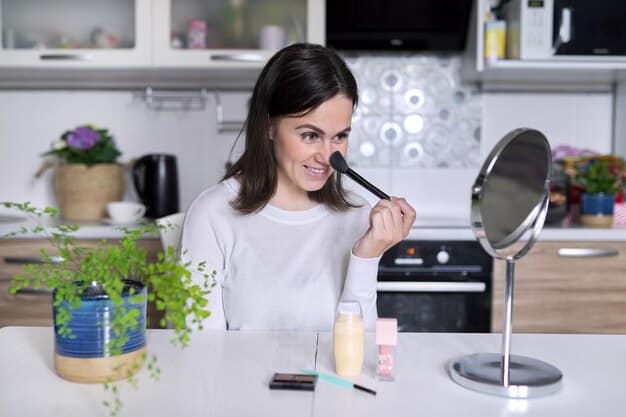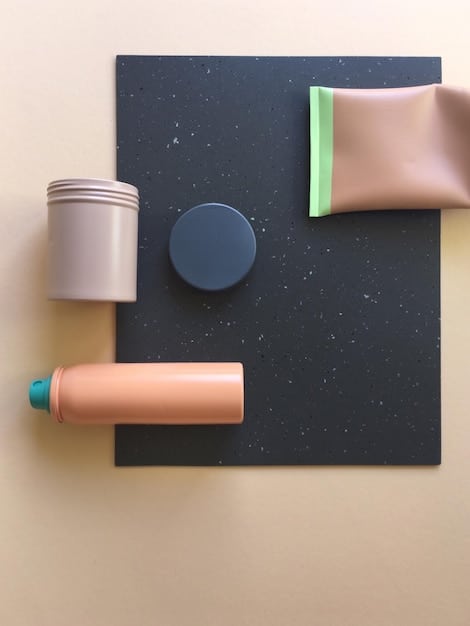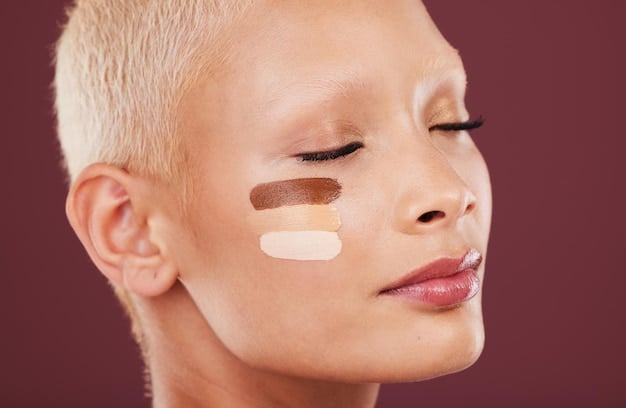The Best Makeup for Your Skin Type: A Comprehensive Guide for 2025

The Best Makeup for Your Skin Type: A Comprehensive Guide for 2025 offers insights into selecting makeup products that cater to your skin’s unique needs, ensuring a flawless look while promoting skin health and preventing potential issues like breakouts or irritation.
Navigating the world of makeup can feel overwhelming, especially when trying to find products that work best for your individual skin type. Let’s dive into **the best makeup for your skin type: a comprehensive guide for 2025**, ensuring you achieve a flawless, healthy look.
Understanding Your Skin Type
Before diving into specific product recommendations, it’s essential to understand your skin type. This knowledge will guide you in selecting makeup that complements your skin’s natural characteristics, preventing issues like clogged pores or dryness.
The Four Basic Skin Types
Identifying your skin type is the first step to selecting the right makeup. Each skin type has unique characteristics and requires specific care.
- Normal Skin: Balanced moisture levels, small pores, and a radiant complexion.
- Dry Skin: Often feels tight, may appear flaky, and can be prone to irritation.
- Oily Skin: Characterized by excessive oil production, enlarged pores, and a tendency for breakouts.
- Combination Skin: A mix of oily and dry areas, typically with an oily T-zone (forehead, nose, and chin) and dry cheeks.
Determining your skin type can be done through observation over a few days, without using any heavy products or makeup. Pay attention to how your skin feels and looks throughout the day.
Understanding your skin type is paramount to making informed makeup choices, ensuring your skin remains healthy and radiant.
Makeup for Oily Skin
Oily skin requires makeup that can control shine, prevent clogged pores, and provide a long-lasting finish. Look for products labeled “oil-free” or “non-comedogenic.”
Best Foundation for Oily Skin
The ideal foundation for oily skin should offer a matte finish and oil-absorbing properties. Ingredients like silica and clay can help control excess oil.
Powder foundations or liquid foundations with a matte finish are generally recommended. Avoid creamy or dewy foundations that can exacerbate oiliness.

Top Product Recommendations
- Primer: Use an oil-free primer to create a smooth base and control shine.
- Foundation: Opt for a matte, oil-free, or powder foundation.
- Powder: Set your makeup with a translucent powder to absorb excess oil throughout the day.
By choosing the right products, those with oily skin can achieve a flawless, shine-free look that lasts all day. Regular cleansing and exfoliation are also essential to prevent breakouts.
Makeup for Dry Skin
Dry skin needs makeup that provides hydration and prevents further moisture loss. Look for products with moisturizing ingredients like hyaluronic acid and glycerin.
Choosing Hydrating Foundations
Creamy and hydrating foundations are ideal for dry skin, as they provide moisture and prevent flakiness. Look for products with hydrating ingredients like hyaluronic acid and shea butter.
Avoid matte or powder foundations, as they can accentuate dryness and create a cakey appearance. Instead, opt for foundations with a dewy or satin finish.
Essential Products for Dry Skin
- Moisturizing Primer: Hydrates the skin and creates a smooth base for makeup.
- Hydrating Foundation: Provides coverage while keeping the skin moisturized.
- Cream Blush: Adds a touch of color without drying out the skin.
Proper hydration is crucial for dry skin. Drink plenty of water and use a humidifier to maintain skin moisture levels. With the right makeup and skincare routine, you can achieve a radiant, hydrated complexion.
Makeup for Combination Skin
Combination skin presents a unique challenge, requiring a balanced approach to address both oily and dry areas. Multitasking products and targeted application are key.
Balancing Oily and Dry Areas
Focus on using different products for different areas of the face. Use a matte foundation on the T-zone and a hydrating foundation on the cheeks.
Consider using a lightweight moisturizer on dry areas and a mattifying primer on oily areas. This targeted approach ensures each area receives the specific care it needs.

Product Recommendations for Combination Skin
- Mattifying Primer: Apply to oily areas to control shine.
- Hydrating Foundation: Use on dry areas to provide moisture.
- Blotting Papers: Keep on hand to absorb excess oil throughout the day.
Effectively managing combination skin involves understanding its dual nature and using products that cater to each area’s specific needs. Proper cleansing and exfoliation are also vital.
Makeup for Sensitive Skin
Sensitive skin requires makeup that is gentle, hypoallergenic, and free of irritants like fragrances and parabens. Always perform a patch test before using new products.
Choosing Gentle Products
Look for makeup labeled “fragrance-free,” “paraben-free,” and “hypoallergenic.” Mineral makeup is often a good choice for sensitive skin, as it contains fewer potential irritants.
Avoid products with harsh chemicals or dyes. Read ingredient lists carefully and choose products with natural, soothing ingredients like aloe vera and chamomile.
Tips for Sensitive Skin Care
- Patch Test: Always test new products on a small area of skin before applying them to your entire face.
- Gentle Cleansing: Use a mild, fragrance-free cleanser to avoid irritation.
- Minimal Ingredients: Choose products with as few ingredients as possible to reduce the risk of reactions.
Caring for sensitive skin involves choosing products that are gentle and free of potential irritants. A simple skincare routine and careful product selection are essential for maintaining healthy, calm skin.
Future Trends in Makeup for Skin Types (2025)
Looking ahead to 2025, several trends are expected to shape the future of makeup for different skin types. These include advancements in personalized beauty, sustainable products, and multi-functional formulations.
Personalized Beauty Solutions
In 2025, expect to see more personalized makeup solutions tailored to individual skin needs. AI-powered tools and personalized formulations will become increasingly common.
Customizable foundations and skincare-infused makeup will allow consumers to create products that perfectly match their skin type and tone, addressing specific concerns and preferences.
Sustainable and Ethical Makeup
- Eco-Friendly Packaging: Brands will increasingly use recycled and biodegradable packaging.
- Clean Ingredients: Focus on natural, sustainable, and ethically sourced ingredients.
- Refillable Products: More brands will offer refillable options to reduce waste.
As consumers become more conscious of their environmental impact, the demand for sustainable and ethical makeup will continue to grow. Brands that prioritize sustainability will gain a competitive edge.
Conclusion
Choosing the right makeup for your skin type is essential for achieving a flawless, healthy complexion. By understanding your skin’s unique needs and selecting products accordingly, you can enhance your natural beauty and prevent potential skin issues. In 2025, expect to see more personalized, sustainable, and multi-functional makeup options that cater to individual skin types, making it easier than ever to achieve your desired look while promoting skin health.
“`html
| Key Point | Brief Description |
|---|---|
| 💧 Hydration for Dry Skin | Use creamy foundations and moisturizing primers. |
| ✨ Matte Finish for Oily Skin | Opt for oil-free foundations and setting powders. |
| 🌿 Gentle Products for Sensitive Skin | Choose hypoallergenic and fragrance-free options. |
| ⚖️ Balancing Combination Skin | Use different products for oily and dry areas. |
“`
Frequently Asked Questions
▼
Observe your skin over a few days without using heavy products. Note if it feels tight (dry), looks shiny (oily), or has a mix of both (combination). Normal skin feels balanced.
▼
Yes, some makeup contains beneficial ingredients like antioxidants and hydrating compounds. Choose products that offer both coverage and skincare benefits for your skin type.
▼
Replace mascara every 3 months, liquid foundation every 6-12 months, and powder products every 1-2 years. Always check for changes in texture or smell, which indicate spoilage.
▼
Yes, primer creates a smooth base, helps makeup last longer, and can address specific skin concerns. Choose a primer suited to your skin type (hydrating, mattifying, etc.).
▼
Avoid using expired products, skipping skincare prep, applying too much foundation, and not cleaning your makeup brushes regularly. These habits can lead to skin issues.
Conclusion
Understanding your skin’s needs is paramount when selecting makeup. By tailoring your choices to your specific skin type and staying informed about future trends, you can achieve a flawless look while maintaining optimal skin health.
“`





